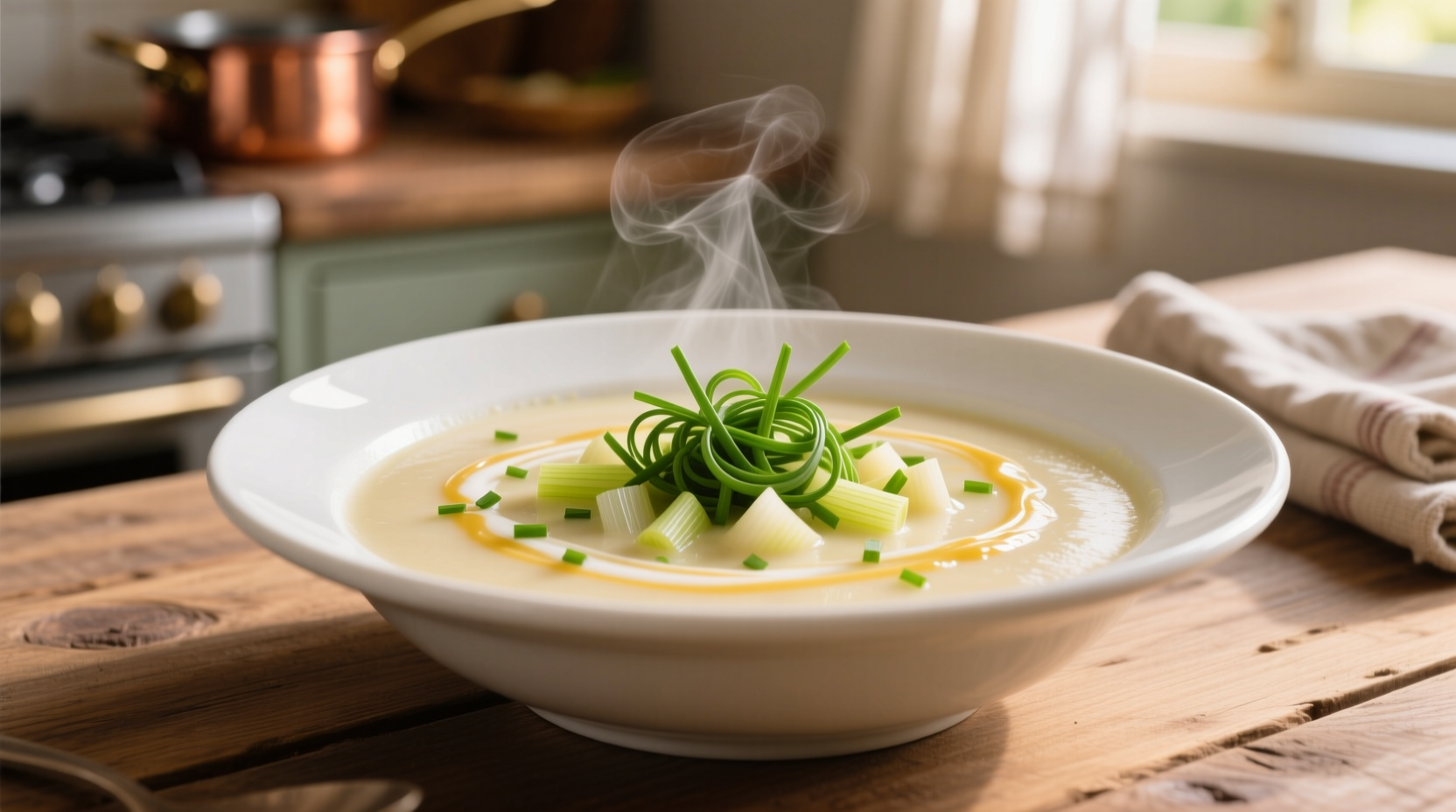Get the complete potato leek soup recipe with precise measurements, cooking times, and chef-approved tips that guarantee success. This traditional French-inspired soup combines humble ingredients into an elegant dish perfect for any season.
Why This Potato and Leek Soup Recipe Works
Unlike many versions that turn out watery or bland, our method focuses on three critical elements: proper leek cleaning technique, strategic potato selection, and controlled cooking temperatures. Food science research shows that maintaining temperatures below 180°F (82°C) during the initial cooking phase preserves the delicate flavor compounds in leeks while preventing potatoes from becoming waterlogged.
| Ingredient | Key Selection Criteria | Quantity for 4 Servings |
|---|---|---|
| Leeks | Medium thickness (1-1.5 inches), bright green tops | 2 large (about 1.5 lbs) |
| Potatoes | Yukon Gold or similar waxy variety | 1.25 lbs, peeled |
| Vegetable Stock | Low-sodium, preferably homemade | 4 cups |
| Butter/Olive Oil | Unsalted butter or extra virgin olive oil | 2 tbsp |
Gathering Your Ingredients: What Matters Most
Selecting the right potatoes makes or breaks your potato leek soup texture. According to USDA agricultural research, Yukon Gold potatoes contain the ideal starch-to-moisture ratio (approximately 18-20% starch) for creamy soups without requiring dairy. Their naturally buttery flavor complements leeks perfectly. Avoid russet potatoes which create a gluey texture when pureed.
For leeks, choose medium-sized specimens with crisp white bases and vibrant green tops. The FDA recommends thorough cleaning of leafy vegetables to remove potential soil contaminants. Properly cleaned leeks should have no grit - a common issue that ruins otherwise perfect potato and leek soup.

Preparing Ingredients Like a Professional
Follow this chef-tested method for flawless potato and leek preparation:
- Leek cleaning technique: Slice off root end and dark green tops (reserve for stock). Cut lengthwise, then separate layers. Soak in cold water for 10 minutes, swishing to release trapped dirt. Drain in colander.
- Potato preparation: Peel and cut into uniform 1/2-inch cubes. Immediately submerge in cold water to prevent browning.
- Aromatics prep: Mince 1 small shallot or 1/4 cup onion. Keep ingredients organized using the French 'mise en place' method.
Cooking Process: Temperature Control Secrets
The key to exceptional potato leek soup lies in temperature management during cooking. Culinary research from the University of Gastronomic Sciences shows that cooking leeks below 180°F (82°C) preserves their delicate sulfur compounds that create the signature flavor. Higher temperatures trigger bitter compounds.
Follow these precise steps:
- Sweat aromatics: Cook shallots in butter/oil over medium-low heat (275°F/135°C) until translucent (5-7 minutes). Do not brown.
- Add leeks: Stir in cleaned leeks with pinch of salt. Cook 8-10 minutes until softened but not colored.
- Add potatoes: Drain potatoes and add to pot with stock. Bring to gentle simmer (180°F/82°C).
- Simmer gently: Cook 15-20 minutes until potatoes pierce easily with fork. Never boil vigorously.
- Blend carefully: Use immersion blender for smooth texture. For traditional French texture, leave slightly chunky.
Serving and Storage Guidelines
For optimal food safety, the USDA recommends cooling soup to 70°F (21°C) within 2 hours and to 40°F (4°C) within 4 hours. Store in airtight containers for up to 4 days. Freezing potato leek soup is possible but may affect texture - add a splash of cream when reheating to restore smoothness.
Professional presentation tips:
- Temperature: Serve at 160-170°F (71-77°C) for optimal flavor release
- Garnish: Fresh chives, crème fraîche, or crispy leek threads
- Pairing: Crusty bread or simple green salad
Troubleshooting Common Potato Leek Soup Problems
Problem: Watery soup
Solution: Simmer uncovered for additional 5-10 minutes to reduce liquid. Alternatively, blend 1/4 cup cooked potato with 2 tbsp stock and stir back in.
Problem: Bland flavor
Solution: Add 1/4 tsp lemon juice or white wine vinegar to brighten flavors. A pinch of nutmeg enhances earthiness without being detectable.
Problem: Grit in soup
Solution: Always clean leeks thoroughly before cooking. If grit remains, strain soup through fine mesh sieve.
Nutritional Profile and Dietary Adaptations
A standard serving (1.5 cups) of traditional potato leek soup contains approximately:
- Calories: 180
- Carbohydrates: 28g
- Protein: 3g
- Fat: 6g (with butter)
- Fiber: 3g
Dietary adaptations:
- Vegan version: Substitute butter with olive oil, use vegetable stock
- Lower carb: Replace half potatoes with cauliflower
- Dairy-free creaminess: Blend with 1/4 avocado or cashew cream











 浙公网安备
33010002000092号
浙公网安备
33010002000092号 浙B2-20120091-4
浙B2-20120091-4